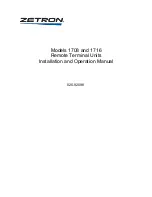
6. HX3040 Redundancy
303
o
RedUsrLoc: CPU 128-byte memory area, which will be transferred to the RedUsrRem data
structure of the remote CPU. Is used for the user to exchange information between CPUA
and CPUB. This section is described in User Information Exchanged among CPUA and
CPUB.
o
RedUsrRem: CPU 128-byte memory area, which corresponds to the RedUsrLoc data structure
of the remote CPU. Is used for the user to exchange information between CPUA and CPUB.
This section is described in User Information Exchanged among CPUA and CPUB.
It is important to note that the redundancy diagnostics structures of remote CPU are updated only
when data synchronization occurs successfully. Therefore, while a new synchronization does not
occur, the diagnostics will remain with the frozen value, corresponding to the last successful data
exchange.
In addition, the remote CPU structures are read-only, that is, values written in these structures will be
overwritten without being considered, the next data synchronization. Therefore, you cannot use the
RedCmdRem structure to execute a command on remote CPU. The structure used to execute
commands, to be written, should always be RedCmdLoc.
Redundancy Diagnostics
The diagnoses of redundancy can have multiple uses. Among them:
Can be used to verify the existence of a problem that needs to be remedied.
Can be used to query the status of the system, as well as actions to be taken in case of failures or
variations of diagnostic values. The main events related to redundancy system diagnoses are
presented as events in system logs. Referring to the historical sequence of such events can find
out, for example, the cause of a switchover.
ATTENTION:
The diagnosis DG_HX3040_01. RedDgnLoc. sGeneral_Diag. bExchangeSync (defined next) should
be tested to see if the RedDgnRem data structure has been read successfully from remote CPU in the
last cycle of MainTask. If the value of this diagnosis is FALSE, this means that the RedDgnRem
data structure was not read successfully from remote CPU and therefore the RedDgnRem values
may be invalid or outdated.
As RedDgnRem is a copy of RedDgnLoc from another CPU, both structures have the same format.
These are still divided into four substructures:
RedundancyDiagnostics: general diagnostics of redundancy
SyncLinkDiags [1]: A sync channel diagnostics
SyncLinkDiags [2]: B sync channel diagnostics
SyncLinkStatistics: common statistics for sync channels A and B, for count of successes and
failures of synchronization services
The substructure "RedundancyDiagnostics" has the following fields for general diagnostics of
redundancy:
.RedundancyDiagnostics.*
Type
Description
bConfigDone
BOOL
TRUE - The configuration process, run on non-configured state, has finished.
FALSE - The configuration process, run on non-configured state, still not ended or was not
run.
bConfigError
BOOL
TRUE - The configuration process, run on non-configured, finished with errors. This is a
system error, not usually expected. Contact Altus support for reporting it. Notify also the
diagnostic value of ConfigErrorCode to Altus support.
FALSE - The configuration process successfully occurred or was not performed.
bTooManyRedAreas
BOOL
TRUE
– The number of redundant areas has exceeded the maximum number allowed.
This is a system error, not usually expected. Contact Altus support for reporting it.
FALSE
– The number of redundant areas are within the expected.
bTemporaryBufferTooSmall
BOOL
TRUE
– Intermediate data structure with insufficient size. This is a system error, not usually
expected. Contact Altus support for reporting it.
















































